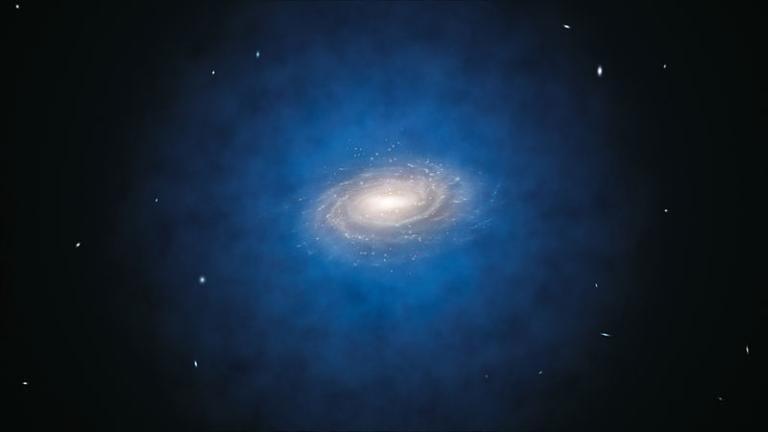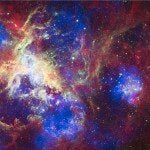
(Wikimedia CC; European Southern Observatory)
I was struck by a passage about dark energy and dark matter — as opposed to the ordinary “baryonic” matter that we see, sense, and measure — in Jeff Wynn and Louise Wynn, Everyone is a Believer: The Growing Convergence of Science and Religion (2019), 29:
What we can directly sense and measure is just 4% of what we know by indirect means to be out there, and the biosphere is an immensely tiny faction of that.
A couple of atheists who regularly comment on my blog have been assuring the rest of us over and over and over again that the possibility of spiritual beings and life after death and so forth is completely excluded by the nature of matter and the rules of physics and the laws of biology and biochemistry that we currently know. Their faith is strong.
In any event, the Wynns’ comment reminded me of a column that I published in the Deseret News back on 13 August 2015:
Among the notable characters in C.S. Lewis’ novel “That Hideous Strength” — the concluding book in his Perelandra trilogy — is the scientist Mr. MacPhee, a sturdy-minded and skeptical rationalist based on the young Lewis’ own beloved tutor William Kirkpatrick. MacPhee’s intellectual descendants still flourish in atheistic and agnostic circles today. But his simple, stout, commonsense materialism badly needs major revision.
Although the Greek word “atom” means “indivisible,” we’ve known for decades that atoms are actually composed of protons, neutrons and electrons — and can be split. Further, along with the rest of the universe, they’re being divided into even smaller “subatomic particles” bearing such names as “lepton,” “neutrino,” “gluon,” “muon,” “boson,” “hadron,” “baryon” and “meson.” Particles called “quarks” come in six “flavors”: “up,” “down,” “bottom,” “top,” “strange” and “charm.” Many particles have mass. But photons and gluons don’t.
Moreover, we now know matter not to be solid, but mostly empty space (though “empty space,” too, may be problematic). If, for instance, the nucleus of a hydrogen atom were expanded to basketball-size and placed at the center of the Earth, its single orbiting electron would be somewhere out in Earth’s atmosphere.
Further, old models long familiar from school textbooks and classrooms are misleading: Atoms aren’t made up of submicroscopic objects resembling billiard balls. Electrons don’t orbit their nuclei as planets revolve around our sun. Like photons, electrons seem to be both particles and waves. And, according to Werner Heisenberg’s famous “Uncertainty Principle,” to the extent that the position of an elementary particle is known, its momentum cannot be known — and vice versa.
Such things are difficult to understand, let alone to picture. But one conclusion seems obvious: “The universe is not only queerer than we suppose,” the scientific polymath J.B.S. Haldane famously remarked, “it is queerer than we can suppose.”
We’re sometimes advised to believe only what we see. But how many of us have actually seen an electron? And how commonsensical is the notion, from Albert Einstein’s General Theory of Relativity, that space itself (or, perhaps more precisely, “spacetime”) is “curved”? How much room does Einstein’s Special Theory of Relativity leave for our sense of material things when it says that mass and energy are equivalent? And what of the current cosmological understanding that matter — and, indeed, the universe itself — may have arisen from “quantum fluctuations” in a vacuum?
Consider, too, the new world discussed in Richard Panek’s 2011 book “The 4 Percent Universe: Dark Matter, Dark Energy and the Race to Discover the Rest of Reality”: Only 4.56 percent of our universe, which seems to have originated in an inconceivable explosion roughly 13.75 billion years ago, is “baryonic matter.” That’s the matter that we know, the matter that we can often see and sometimes touch, the stuff of which stars, planets, mountains, pine trees, Porsches, buildings and kittens are made. The rest of the universe, we’ve only recently discovered, is “dark matter” (22.7 percent) and “dark energy” (72.8 percent) — figures that, Panek writes, offer “an exquisitely precise accounting of the depth of our ignorance.” “Dark matter” and “dark energy” cannot be seen but only indirectly detected, and we don’t really know what they are.
None of this proves that God exists, obviously, but it surely encourages humility. And it offers some other tantalizing possibilities, too:
One should, of course, never tie one’s theology too closely to current scientific theories, because they change. But might Mormonism’s notions of “pure” and “refined” matter — what Catholic philosopher Stephen Webb terms Mormonism’s “Christian materialism” — have something theologically and philosophically important to say in this new situation?
“Could it be,” he asks, “that (Joseph) Smith … foresaw a middle ground between Plato’s immaterialism and the secular, atheistic ideology of materialism?”
“By arguing that only the physical is real,” he writes, “and that the divine is physical in ways that we can only glimpse in this world, Mormon metaphysics actually has some advantages over more traditional metaphysical schemes that emphasize the immateriality of the divine. Most significantly, Mormonism can address directly and sympathetically the question of materialism that lies at the heart of modern atheism. … The case can be made that the most serious alternative to fundamentalism and Catholicism in terms of having the resources to turn back the tide of modernity is The Church of Jesus Christ of Latter-day Saints.”
For his argument, see Webb’s “Mormon Christianity: What Other Christians Can Learn from the Latter-day Saints” (Oxford, 2013).












